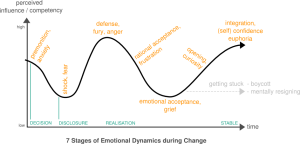Two weeks ago some colleagues and me took part in a seminar on “Removing Impediments / Change Management”. The main point we took away is that change is all about emotions:
- Each change invokes emotions – positive and negative ones.
- The positive are accepted, while the negative are unwanted and dismissed as resistance.
- But you need to be aware of emotional undercurrents and address them. (Emotions are contagious and you don’t want negative emotions to spread.)
- People’s feelings pass through 7 stages that are analog to those of grieving:

-
1st: There are rumors about change to come. People are apprehensive and might agitate against it.
-
2nd: Shocking news: Change is coming, it’s official.
- 3rd: When the change is introduced, there’s often resistence. People try to preserve the old ways and think if they only hold out long enough the change will get reverted.
- 4th: Nope, the change is here to stay. They know it rationally. No more rebellion, but no happy feelings either.
- 5th: It finally sinks in, that the changes are really here to stay. Now they feel it in their guts. And it hurts to let go.
- 6th: Letting go enables people to explore the new way -> “Sure, it’s different, but it needn’t be worse.”
- 7th: “Wow, this is fun! I can do this!”
In some occasions you pass through the stages in seconds, sometimes it takes years and sometimes you get stuck in a stage (often the 5th) and never regain a positive outlook and feeling of control.
-
Note, that people are not necessarily aware of their emotions while going through the stages. We all tend to rationalize and give reasons for certain behavior, without knowing that it stems from what we feel. I know a range of people (technical people appear to be prone to this) who seem to believe that it is beneath them to be steered by emotions instead of fact. Using the model of the 7 stages you can help people realize what stage they’re at, thus connect to their emotions and find a way to move on.
